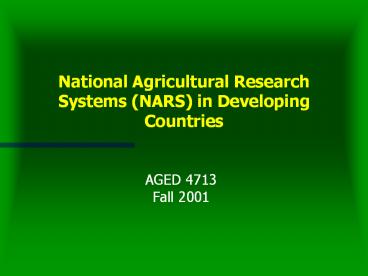National Agricultural Research Systems (NARS) in Developing Countries - PowerPoint PPT Presentation
1 / 25
Title:
National Agricultural Research Systems (NARS) in Developing Countries
Description:
The NARS in Developing countries include all the various ... Honey Bee. Areas of specialization. Animal health. Epidemiology. Parasitology. Microbiology ... – PowerPoint PPT presentation
Number of Views:2420
Avg rating:3.0/5.0
Title: National Agricultural Research Systems (NARS) in Developing Countries
1
National Agricultural Research Systems (NARS) in
Developing Countries
- AGED 4713Fall 2001
2
NARS definition
- The NARS in Developing countries include all the
various national organizations which undertake
agricultural research in their respective
countries.
3
Responsibility of NARS
- To conduct research to develop and adapt
technology and to participate in the transfer of
technology.
4
Advantages of NARS
- Direct institutional /client linkages
- Close proximity to farmers problems
- Ability to collect field-level data relatively
inexpensively - On-site staff and facilities
- Effective conduit for communicating development
strategy and policies to policy makers
5
Types of NARS
- Publicly supported (centralized)
- Collaborative federal/state agricultural
research systems (decentralized ) - Endowed research institutes
- Agricultural Universities
- Private sector research institutes
- Non-governmental Organizations
- Multinational, regional research institutes
6
Publicly supported (centralized)
- Systems that are dependencies of , controlled
by, and receive their financial support from the
Ministry of Agriculture or other ministry in the
federal government. - Examples
- Brazil Empresa Brasileira de Pesquisa
Agropecuaria (Embrapa) - Kenya Kenya Agricultural Research Institute
(KARI) - Pakistan Pakistan Agricultural Research Council
(PARC)
7
NARS in developing countries
- Embrapa's mission is to provide feasible
solutions for the sustainable development of the
Brazilian agribusiness by generating, adapting
and transferring knowledge and technology that
benefits the Brazilian Society.
http//www.embrapa.br/english/
8
- Embrapa coordinates the National Agricultural
Research System with cooperated institutions
carrying out research in geographical areas or in
defined fields of scientific knowledge. - Networking through 37 research units.
- 2 045 researchers.
- 47 master's
- 49 Ph Ds
9
Collaborative federal/state agricultural research
systems (decentralized )
- Systems that channel federal, state, private
sector, and producers(commodity associations)
funding to semi-autonomous state level research
and extension programs. - Programs are commodity linked with disciplinary,
cross commodity programs - Research/extension linkage close,
assembling/adapting technology to producers
needs. - Example
- Mexico INIFAP
10
Agricultural, Livestock and Rural Development,
Fishing and Food Secretariat
www.sagarpa.gob.mx
11
Institutions funded by SAGARPA
www.sagarpa.gob.mx
Semi-autonomous
12
Mexican NARS
- The National Institute of Forestry, Livestock
and Agricultural Research - It is a decentralized administrative entity of
SAGARPA
http//www.inifap.conacyt.mx
13
- Collaborative federal/state agricultural
research systems (decentralized ) - Funded by
- Federal
- State
- Producers (Fundacion Produce)
14
Objectives
- To develop and strengthen National Strategic
Research - To support research for sustainable natural
resources management - To promote applied research and technology
transfer
15
- 1246 researchers. 56 master's 16 Ph
Ds - 82 PhD students in European and U.S. Universities
16
8 Regional Research Centers (CIR)81 Research
Stations 6 National Centers
17
Research Programs
- 108 Crops
- Avocado
- Beans
- Barley
- Cacao
- Corn
- Citrus
- Chile
- Coffee
- Cotton
- Mango
- Rice
- Soybean
- Wheat
- Areas of specialization
- Biotechnology
- Entomology
- Integrated resources Management
- Plant genetics
- Irrigation systems
- Rain fed land management
- Mechanization
- Biofertilization
- Corn Protein gene(opaco)
18
Research Programs
- Livestock
- Dairy Cattle
- Dual Purpose
- Sheep
- Goat
- Red deer
- Pig
- Poultry
- Honey Bee
- Areas of specialization
- Animal health
- Epidemiology
- Parasitology
- Microbiology
- Nutrition
- Reproduction
- Genetics
19
Technology transfer programs
20
Agricultural universities
- Institutions of higher learning that provide
undergraduate and graduate education and grant
related degrees, conduct research, and distribute
information to agricultural sector clientele.
21
Agricultural universities
- Autonomous, some semi-autonomous
- Structure Centralized
- Funding sources Public-federal and state
- Nature of programs education some research and
extension - Limited research
- Limited extension linkages
- Linkage with international/multinational
programs
22
Agricultural universities Mexico(SAGARPA
supported)
Universidad Autonoma Agraria Antonio Narro,
Saltillo Coahuila
Universidad Autonoma Chapingo, Texcoco Estado de
Mexico
Colegio de Postgraduados en Ciencias Agricolas
Chapingo, Texcoco Estado de Mexico
23
Universidad Nacional Autónoma de México UNAM
- Decentralized
- Autonomous
- Funded by Federal Government
- Secretary of Education
- UNAM Foundation private support (10)
- Competitive funds for research CONACYT
- Mission
- Teaching, Research and Outreach
24
Universidad Nacional Autónoma de México UNAM
- 85 of research in Mexico
- Comprehensive University (4-5 years)
- 68 Colleges offer 130 careers (269 000
Students) - Faculty (College) of Veterinary Medicine and
Zootechnics ( 2 campuses gt3500 students) - Faculty of Agricultural Sciences (1000 students)
25
Any Questions ?































